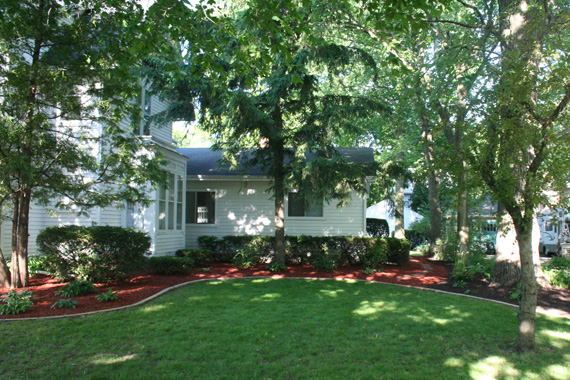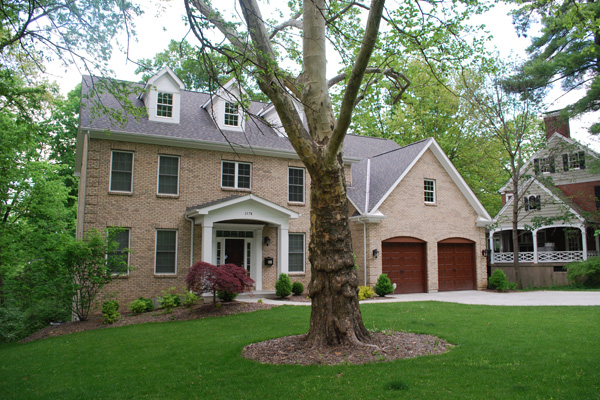
Maintaining an acre of native plants over 20 years costs $3,000, compared with $20,000 for maintaining a lawn of non-native turf grass. Image: Loree Bohl
Your home is your castle — enjoy it, customize it, make it reflect your taste and values. But, there’s one area where being too individualistic carries risk: landscaping for curb appeal.
Landscaping is the first thing that potential buyers see, and it reflects well — or poorly — on other homes in the neighborhood. That’s why homeowners associations often have exacting rules for it.
Good landscaping can add up to 28% to overall home value, says landscape economist John Harris. Even taking your landscaping from “good” to “excellent,” in terms of design, condition, and placement, can add 6% to 7% to a home’s value, according to a Clemson University study of homes in Greenville, S.C.
But don’t landscape merely to flip a house. You won’t get your money back, says Sandy MacCuish, a California appraiser. Rather, landscape for your enjoyment, knowing that you’re making a good investment.
Here are the essentials for great landscaping.
Essential #1: Trees
 Image: Robin Zebrowski
Image: Robin Zebrowski
Maybe only Mother Nature can make a tree, but the National Tree Benefit Calculator can tell you what it’s worth.
The calculator examines how a tree species in a particular ZIP code affects:
- Property values.
- Storm water runoff. Trees block and suck up water running off your property, preventing pollutants from entering community waterways.
- Carbon dioxide reduction. CO2 contributes to climate change.
- Energy savings: Shade trees cool homes in summer; windbreaks help warm them in winter.
Take a 24-in. diameter red maple, the country’s most popular tree. Here’s its overall annual benefit, combining the factors above, in a handful of cities, according to the tree benefit calculator:
- McLean, Va.: $244
- Scarsdale, N.Y.: $181
- Beverly Hills, Calif.: $207
Multiply those benefits by the number of trees on a property, and the value and savings can climb.
To calculate the dollar value of an individual tree, the Purdue University Cooperative Extension Service in Indiana uses a formula that includes the tree’s size, cost, health, and position in a yard. By its calculations, a 15.75-inch silver maple in good health could be worth $2,562.
Value of Neighboring Trees
 Image: Liz Foreman for HouseLogic
Image: Liz Foreman for HouseLogic
Your trees can even add value to your neighbor’s property. A Portland, Ore., study found that trees with a sizable canopy growing within 100 feet of other houses added about $9,000 to their sale price and shaved two days off its time on the market.
Of course, to add value, the trees must be healthy, mature but not elderly, native to the area (more on the importance of native plants later), and appropriate to the neighborhood.
If you’re growing a forest and the rest of the neighborhood looks like a prairie, you’ll have a hard time recovering the trees’ value at sale. Conversely, if your neighbors manicure their lawns and yours is a jumble of weeds or worse, their great landscaping will make yours look even shabbier and hurt the value of your home, says Domenich Neglia of Neglia Appraisals in Brooklyn, N.Y.
Related: Avoid These Troublesome Trees
More Fun Facts About Trees
- Just three properly placed trees could save you between $100 and $250 a year in energy costs, says the U.S. Department of Energy.
- Planting windbreaks and shade trees can reduce winter heating bills by 15% and air conditioning needs by 75%.
- Just looking at trees produces “significant recovery from stress” within five minutes, according to a Texas A&M University study.
Essential #2: Native Plants
 Image: Night and Day Landscape Design
Image: Night and Day Landscape Design
If you introduce trees, plants, or shrubs, go native. Indigenous plantings thrive without the extra TLC (read: time and money) you’ll devote to anything that’s forced to live outside its natural habitat.
A study by Applied Ecological Services Inc., a Wisconsin ecological consultancy, shows that maintaining an acre of native plants over 20 years costs $3,000, compared with the whopping $20,000 price tag of maintaining a lawn of non-native turf grass.
Related: The Plants That’ll Hijack Your Yard!
Not only can native plantings save money, they can make you money, too. In Mesa, Arizona, a generous assortment of lovely Saguaro and other native cacti can boost a home’s value by $500 to $5,000, depending on size, says REALTOR® Cathy Joyce.
Native plantings help wildlife, too. The National Wildlife Federation awards a special certification to homeowners who create natural backyard habitats for birds, butterflies, and other animals looking for places to roost or feed.
There’s a slow but steady increase in buyers seeking these wildlife certified properties; a recent listing for a West Virginia property trumpeted its wildlife certification, restored meadow, and organic garden.
Rain gardens with native plants and trees also are becoming a plus for properties increasingly plagued by extreme weather. These gardens filter and distribute runoff underground, preventing storm water from seeping into basements and overwhelming municipal sewers.
In the Chicago area, now frequently drenched by huge storms, rain gardens can make properties more marketable and can reduce flood insurance rates, says Laura Reedy-Stukel, a REALTOR® in Elmhurst, Ill., who specializes in green building strategies.
Essential #3: Outdoor Lighting
 Image: Dekor
Image: Dekor
Outdoor lighting consistently tops the NAHB’s list of most wanted outdoor features in its annual “What Home Buyers Really Want” survey: 41% rate it “essential;” 49% say it’s “desirable.”
But that’s not the only reason it’s one of our landscape essentials.
- Tasteful lighting paints your home at night, highlighting your other great landscaping choices and directing guests to your home’s focal point — the front door.
- It protects against slips and falls.
- It makes a property a more difficult target for intruders. That added security can reduce burglaries, and therefore claims. Some insurance companies give 5% to 15% discounts to homeowners with reduced or zero claims.
- It makes your home feel homier. Soft lighting on a wrap-around porch or just a front stoop feels warm and inviting.
Related: Tips for Great Outdoor Lighting
Nice-to-Have #1: Fencing
 Image: Liz Foreman for HouseLogic
Image: Liz Foreman for HouseLogic
Fencing has many indisputable qualities: It keeps pets in and intruders out; it creates privacy and sets boundaries.
But when it comes to boosting property values, the value of fencing becomes murky.
Since most privacy fencing is installed in backyards, it doesn’t pack the curb appeal punch of, say, a spreading chestnut tree shading your house. And if everyone in the neighborhood has the same nice fence, yours won’t earn any extra points on an appraisal sheet.
But nice fences (not chain link) do have value. Douglas Emde, a Stillwater, Okla., appraiser, says cedar picket fences set the standard in his market just north of Oklahoma City, and can boost home value by $1,500 to $2,000. In Meza, Arizona, where chain link fences are typical of older properties, an upgraded cement block privacy wall can boost selling prices by $2,000 to $5,000 more, says REALTOR® Joyce.
Related: What’s Your Fence Style?
Nice-to-Have #2: Retaining Walls and Terracing
 Image: Liz Foreman for HouseLogic
Image: Liz Foreman for HouseLogic
Retaining walls and terracing reclaim heavily sloped yards that are only good for grass (hard to mow) or ground covers (hard to tame).
Retaining walls and terracing:
- Control erosion and surface runoff by slowing the flow of water down a slope.
- Add color and texture to wide stretches of green.
- Turn useless slopes into flat areas for garden beds and walkways.
Done correctly, walls and terracing look beautiful and boost curb appeal. But walls can be pricey, running $15 to $40 per square foot (including labor), depending on materials used. A 20-foot-long, 30-inch-high stone wall can cost between $1,250 and $2,000.
Related: Retaining Wall Ideas
Nice-to-Have #3: Walkways
 Image: Liz Foreman for HouseLogic
Image: Liz Foreman for HouseLogic
Walkways welcome guests to your home. So, you can let visitors trudge through wet grass to your front door, or you can lay down an attractive path. We vote for the attractive path.
You can go whole hog and install a solid stone walkway, which ranges from $11 to $17 per square foot; or use pavers, $9.50 to $17 per square foot. To save money, lay stepping stones with grass between, $1 to $3 per piece.
Walkways are another keep-up-with-the-Joneses upgrade. If you get too fancy, you won’t see a return on your investment; if you don’t meet the standards of the neighborhood, appraisers will punish you.
Related: Walkways that Lead to Great Curb Appeal
Other fab curb appeal projects that typically offer a good ROI, according to “Remodeling” magazine’s annual “Cost vs. Value Report,” include:
- Exterior door replacements. On average nationally, a steel entry door replacement recouped more than 101% of its cost in the 2015 survey.
- Midrange garage door replacements recoup about 88% of the cost.
- Wood deck additions recoup more than 80%.
Reprinted from HouseLogic.com with permission of the NATIONAL ASSOCIATION OF REALTORS®.
Copyright 2015. All rights reserved.

